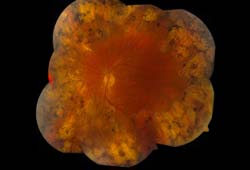Summary
Definition
History and exam
Key diagnostic factors
- family history of vision loss
- history of retinitis pigmentosa
- congenital stationary night blindness
- past medical history of vitamin A deficiency or malignancy
Other diagnostic factors
- decreased visual acuity in dim light
- variable pupillary responses (depending on underlying cause)
- retinal vascular attenuation
- visual field loss
- peripheral chorioretinal degeneration
- history of drugs that interfere with vitamin A metabolism
Risk factors
- retinitis pigmentosa
- congenital stationary night blindness
- vitamin A deficiency
- cancer-associated retinopathy
- melanoma-associated retinopathy
- gyrate atrophy
- choroideremia
Diagnostic tests
1st tests to order
- electroretinography (ERG)
- slit-biomicroscopy and indirect ophthalmoscopy
Tests to consider
- serum vitamin A level
- next-generation-sequencing
Treatment algorithm
genetic night blindness
acquired night blindness
Contributors
Authors
Jonathan Smith, FRCOphth, MRCP
Consultant Ophthalmologist
Sunderland Eye Infirmary
Sunderland
UK
Disclosures
JS has received sponsorship from Novartis, Bayer, and DORC for meeting travel and accommodation. JS was awarded a research grant in 2017 by the British Vitreoretinal Society.
Muhammad Raza Cheema, MRCGP, MRes, FRCOphth, FEBO
Specialist Registrar
Ophthalmology
Sunderland Eye Infirmary
Sunderland
UK
Disclosures
MRC declares that he has no competing interests.
Wendy Adams, MRCP, FRCOphth
Consultant Ophthalmologist
Sunderland Eye Infirmary
Sunderland
UK
Disclosures
WA declares that she has no competing interests.
Acknowledgements
Dr Jonathan Smith, Dr Wendy Adams, and Dr Muhammad Raza Cheema would like to gratefully acknowledge the assistance of Ms Karen Bradshaw. KB declares that she has no competing interests.
Peer reviewers
Makoto Nakamura, MD
Associate Professor
Department of Ophthalmology
Nagoya University Graduate School of Medicine
Nagoya
Japan
Disclosures
MN declares that he has no competing interests.
Eric Amesbury, MD
Klara Spinks Fleming Fellow
Jules Stein Eye Institute
UCLA
Los Angeles
CA
Disclosures
EA declares that he has no competing interests.
Creig S. Hoyt, MD
Emeritus Professor and Chairman
Department of Ophthalmology
University of California
San Francisco
CA
Disclosures
CSH declares that he has no competing interests.
Peer reviewer acknowledgements
BMJ Best Practice topics are updated on a rolling basis in line with developments in evidence and guidance. The peer reviewers listed here have reviewed the content at least once during the history of the topic.
Disclosures
Peer reviewer affiliations and disclosures pertain to the time of the review.
References
Key articles
Hartong DT, Berson EL, Dryja TP. Retinitis pigmentosa. Lancet. 2006 Nov 18;368(9549):1795-809. Abstract
Petzold A, Plant GT. Clinical disorders affecting mesopic vision. Ophthalmic Physiol Opt. 2006 May;26(3):326-41. Abstract
Goodwin P. Hereditary retinal disease. Curr Opin Ophthalmol. 2008 May;19(3):255-62. Abstract
Law WC, Rando RR. The molecular basis of retinoic acid induced night blindness. Biochem Biophys Res Commun. 1989 Jun 15;161(2):825-9. Abstract
Reference articles
A full list of sources referenced in this topic is available to users with access to all of BMJ Best Practice.

Differentials
- Myopia
- Glaucoma
- Optic neuropathy
More DifferentialsGuidelines
- Vision rehabilitation preferred practice pattern
- Standard for full-field clinical electroretinography
More GuidelinesLog in or subscribe to access all of BMJ Best Practice
Use of this content is subject to our disclaimer